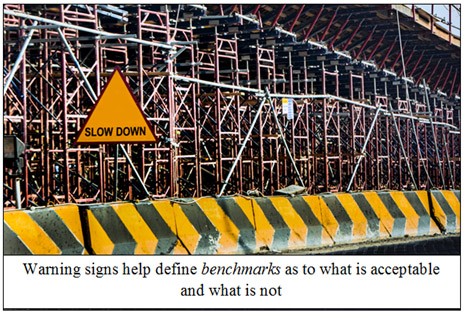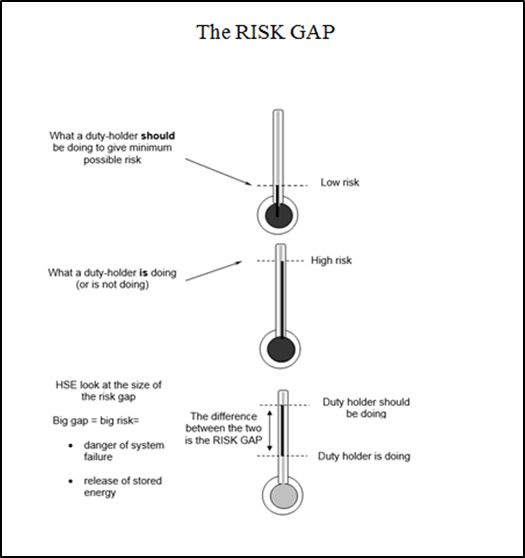Risks: Foreseeability and benchmarks
About foreseeability
Foreseeability is an interesting thing in relation to causing a risk to people. A foreseeability test basically asks whether the person causing the injury should have reasonably foreseen the general consequences that would result because of their actions, or lack of them.
Without getting too far into the legal definitions and interpretation of foreseeability, one way of a risk clearly being classed as foreseeable is if there is a significant accident history resulting from that risk. If there is, it means that, however strange or unusual the circumstances may appear to you, the scenario has happened before and accidents have been the result. To use a simplified example;

- If you are operating a crane on a properly-secured construction site, the risk of a passenger airliner crashing on the site and causing the crane to drop the load during the lift is not reasonably foreseeable. Aeroplanes rarely crash and when they do, it’s not normally into operating cranes Hence you don’t need an observer specifically watching out for approaching plummeting aeroplanes when performing a lift. Neither do you need to monitor the flight paths passing overhead or inform the nearest airport before performing the lift.
- It would be reasonably forseeable however that a site employee or authorized site visitor might wander nearby when the lift was being performed, putting themselves in danger. Hence you would need to have the necessary signs, exclusion zone, observer etc in place to prevent this risk occurring.
If it came to an investigation, the well-documented history of crane accidents should support these interpretations. Lots of people get injured by cranes, but not as a result of nearby crashing aeroplanes
Applying foreseeability to plant integrity
The principle of foreseeability applies to plant mechanical integrity as much as anything else. One of the clearest examples to look at is that of a hydraulic pressure test. Here a component is tested to a code-specified test pressure above its design pressure to demonstrate its integrity and absence of leaks. Hydraulic pressure tests have the following characteristics:
- There are lots of them carried out, for new, in-service and repaired pressure equipment
- They are extremely dangerous if there is an unintentional release of stored energy
- They have a well-documented history of accidents causing injury and death to personnel nearby
- It is very common for personnel to be in close proximity to a pressure test, in order to assess the results
Looking at these, a stored-energy accident during a hydraulic test would almost certainly be classified as being foreseeable, meaning that all necessary precautions would need to be taken to exclude people from the immediate area, to avoid putting them at risk.

What about failure of a corroded component in use?
This is open to more interpretation than the above example but the principles are much the same. The following factors could suggest that a failure of a corroded item was foreseeable:
- Similar corroded items (pipework, vessels, pipelines etc.) have failed before due to similar corrosion
- The corrosion mechanism is known to be particularly unpredictable (such as corrosion under lagging, corrosion of pipework dead-legs)
- The corrosion has already thinned the component to below its calculated minimum acceptable thickness (tmin)
- Previous inspection reports recommended repair or replacement of the component due to the corrosion but nothing was done
Similar foreseeability arguments can apply if the component damage is caused by some damage mechanism (DM) other than corrosion. DMs such as mechanical damage, fatigue, creep, embrittlement and brittle fracture cause as many, if not more, failures of pressure equipment than corrosion with well-established accident histories for most of them.
So what are benchmarks?
Benchmarks are recognized by the HSE Enforcement Management Model (EMM) and play a major part in deciding whether a dutyholder will be prosecuted and, if so, what level of penalties will be appropriate.
Essentially, benchmarks are constraints, setting a limit on the level of risk that is considered acceptable.

How are benchmarks set?
In the world of HSE, benchmarks are set by the existence of laws governing the activity under discussion. Taking as an example, driving a vehicle, benchmarks of acceptability are set by the speed limit of the road and all the other requirements of the road traffic act requiring licensing of vehicle and driver, driving safely, obeying road signs and all the rest. The same principles apply to engineering equipment, where its condition and operation are covered by regulations such as PSSR, LOLER, COMAH, PUWER, HASAWA and any others that apply to it.
In some cases, this can be a complex picture. Overall it makes sense to assume that there are more benchmarks in existence than you have detailed knowledge of, and that they have been around long enough for it to have become well-established as to what they mean.
Benchmarks and the risk gap
When it comes to HSE enforcement, the idea of a risk gap is one of the most important points around. The risk gap is the difference between the benchmark risk (as described above) and the actual risk that you, the duty holder, are creating. The fig below shows the situation. In the eyes of enforcement authorities (of all types) the bigger the risk gap, the more enthusiastic the enforcement activity and the penalties that go with it.

Using the car- driving analogy again, penalties for speeding are arranged in bands, the faster you are caught travelling above the speed limit, the bigger the penalty you get. In an industrial scenario, the greater risk you create above the accepted benchmarks, or the more people you put at risk, the greater the enforcement penalty.
FFP studies: operating plant with known damage
There are many scenarios where operators may like to continue to operate a piece of equipment that has some known corrosion or other damage. This is where things get tricky. The principle of a FFP study is to investigate whether an item corroded/damaged item outside construction code limits can be justified as still safe to use. The existence of the FPP study itself is an indication that the component damage is known about ,so this introduces interesting views on whether any subsequent failure could be considered foreseeable. Have a look at our linked article; FFP studies: THE DANGERS
Try it yourself
You can have a go yourself at deciding the foreseeability of failure that have already happened. Have a look at the examples on our Failure Briefings page and see if you would, given only the information provided ,have considered them foreseeable, and whether there are any benchmarks that you consider applicable.
Matthews Integrity Hub: HEAD OFFICE is OPEN EVERY DAY….0730 – 2200 Monday – Sunday…That’s correct, all week, every week, including holidays
 If we happen to miss your call, leave a message and we will call you back just as soon as we pick it up. Sorry, there’s no automated messages, call queueing, voice recognition tools or canned music. Try it and see.
If we happen to miss your call, leave a message and we will call you back just as soon as we pick it up. Sorry, there’s no automated messages, call queueing, voice recognition tools or canned music. Try it and see.
CONTACT US
Tel: 07746 771592 help@matthewsintegrity.co.uk





